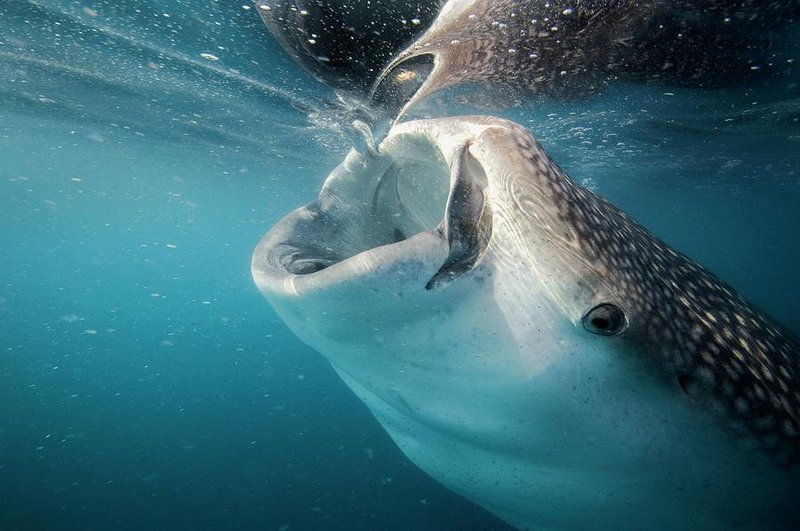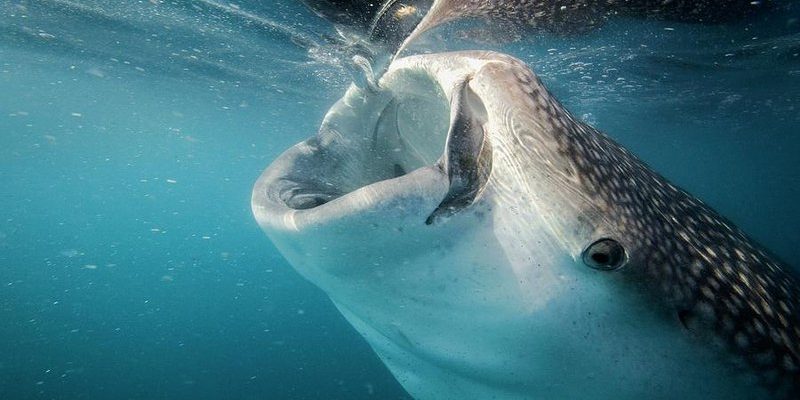
Whale sharks are filter feeders, which means they have a unique way of eating. Instead of hunting for larger prey, they sift through the water to catch small marine life. But what exactly do they eat, and how do they find their food? Let’s dive deeper into their diet and feeding behaviors, exploring the world of these magnificent fish and what makes their eating habits so special.
What Do Whale Sharks Eat?
Whale sharks primarily feed on small creatures like plankton, krill, and small fish. Think of them as gigantic vacuums, sucking in water filled with these tiny snacks. When they open their wide mouths, they can gulp in a massive amount of water, which pours out through their gills, leaving behind the food to be swallowed.
Their diet also includes small schooling fish, which sometimes cluster together, making them easier to catch. Whale sharks have been observed hunting in areas where these fishes are abundant. Honestly, it’s not just a buffet; it’s more like an all-you-can-eat seafood restaurant, where they pick and choose from a host of delights the ocean offers.
In addition to plankton and small fish, whale sharks will often consume eggs from other marine species. This means their menu is varied, giving them the flexibility to adapt to what’s available in their environment. Curious to see what a whale shark’s dinner looks like? Imagine a dinner plate filled with various colorful bits and pieces, just like a well-planned seafood platter.
Feeding Techniques of Whale Sharks
You might be wondering how whale sharks manage to feast on such tiny food while being so large themselves. Their feeding technique is what makes them unique. They use a process called filter feeding. When they swim with their mouths wide open, they create a current that pulls in water and food.
Their gills act like sieves, allowing only the small particles to pass through while keeping the larger debris out. The whale shark’s gill rakers, like natural nets, trap and hold onto their food. It’s a brilliant adaptation to filter out what they need from the ocean, kind of like sieving flour when baking.
Another interesting thing is that whale sharks often feed at the surface of the water, especially during the day. This is where the plankton tends to be more concentrated, thanks to sunlight promoting their growth. So, if you’re lucky enough to spot one of these magnificent creatures during a surface feeding session, it’s not just a sight to behold—it’s a vibrant feeding frenzy!
Where Do Whale Sharks Find Their Food?
Whale sharks are often found in warm waters near coastlines and coral reefs. These areas tend to have a rich supply of plankton and other small marine life, making them prime spots for feeding. They prefer tropical waters, but you can find them in temperate regions too, particularly in places where upwellings bring nutrient-rich waters to the surface.
During certain times of the year, whale sharks gather in significant numbers at specific locations known for abundant food sources. For example, in Mexico, they migrate to the waters off Isla Contoy during the summer months when the plankton blooms. Picture a bustling restaurant filled with large families—everybody’s diving in to get the best bites before it’s all gone!
Interestingly, whale sharks are known to follow the migration patterns of their food. They are capable of traveling long distances, sometimes over thousands of miles, in search of rich feeding grounds. This migration helps them capitalize on seasonal plankton blooms, ensuring they have enough food to sustain their massive bodies.
Impact of Feeding on Ecosystems
Whale sharks play a crucial role in their ecosystems. By feeding on plankton, they help maintain the balance in marine environments. Their presence can indicate a healthy marine ecosystem, where food sources are abundant and diverse.
As they filter out plankton and small fish, they also help control these populations, preventing overpopulation. It’s like having a natural gardener in the ocean, keeping the ecosystem healthy and vibrant. This feeding behavior also provides nutrients to the surrounding waters, promoting the growth of marine plants.
Moreover, their feeding habits can contribute to the development of coral reefs. Healthy coral reefs rely on a balanced diet of nutrients, and whale sharks indirectly support this balance by ensuring a steady supply of plankton, which forms the base of the marine food chain. So, while they may seem like solitary giants, they have a ripple effect that benefits many species in their environment.
Challenges in Their Feeding Grounds
While whale sharks thrive in rich feeding grounds, they face several challenges. Climate change, pollution, and overfishing are significant threats to their food sources. As oceans warm and habitats change, the availability of plankton can fluctuate, putting pressure on these gentle giants.
Pollution can also affect the health of the marine ecosystem. Runoff from land can lead to algal blooms that consume the oxygen in the water and harm the plankton they rely on. Imagine ordering a meal at your favorite restaurant only to find out the chef has run out of ingredients—disappointing, right? That’s the reality for whale sharks when their food supplies diminish due to environmental stressors.
Additionally, overfishing impacts the smaller fish and plankton populations, further reducing the food available for whale sharks. As these challenges arise, conservation efforts are crucial. Protecting their habitats and advocating for sustainable fishing practices can help ensure these magnificent creatures continue to thrive.
The Importance of Conservation
Conservation efforts for whale sharks are essential not just for the species itself but for the health of our oceans. Organizations worldwide are working to protect their habitats, regulate fishing practices, and promote awareness about the importance of these gentle giants.
By supporting marine protected areas and sustainable fishing initiatives, we can help secure a future for whale sharks and the diverse ecosystems they inhabit. It’s vital to remember that our actions on land can have far-reaching effects in the ocean.
You might wonder how you can contribute. Even simple actions, like reducing plastic use or supporting eco-friendly products, can make a difference. Every little bit helps in ensuring that whale sharks have the food they need and the environment they call home.
Ultimately, recognizing the importance of whale sharks in marine ecosystems reminds us that we all share this planet and have a responsibility to protect it. When we prioritize the health of our oceans, we’re not just helping whale sharks—we’re helping ourselves, too.
In summary, the diet and feeding habits of the whale shark offer a glimpse into the fascinating world of marine life. From their unique feeding techniques to their essential roles in the ecosystem, these gentle giants remind us of the importance of conservation and the delicate balance of ocean life. By understanding and protecting them, we contribute to a healthier, more vibrant ocean for generations to come.

